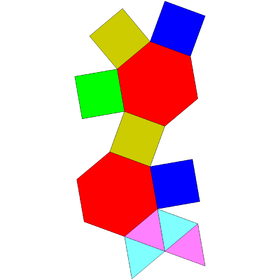|
Augmented hexagonal prism
In geometry, the augmented hexagonal prism is one of the Johnson solids (J54). As the name suggests, it can be constructed by augmenting a hexagonal prism by attaching a square pyramid (J1) to one of its equatorial faces. When two or three such pyramids are attached, the result may be a parabiaugmented hexagonal prism (J55), a metabiaugmented hexagonal prism (J56), or a triaugmented hexagonal prism (J57). ConstructionThe augmented hexagonal prism is constructed by attaching one equilateral square pyramid onto the square face of a hexagonal prism, a process known as augmentation.[1] This construction involves the removal of the prism square face and replacing it with the square pyramid, so that there are eleven faces: four equilateral triangles, five squares, and two regular hexagons.[2] A convex polyhedron in which all of the faces are regular is a Johnson solid, and the augmented hexagonal prism is among them, enumerated as .[3] Relatedly, two or three equilateral square pyramids attaching onto more square faces of the prism give more different Johnson solids; these are the parabiaugmented hexagonal prism , the metabiaugmented hexagonal prism , and the triaugmented hexagonal prism .[1] PropertiesAn augmented hexagonal prism with edge length has surface area[2] the sum of two hexagons, four equilateral triangles, and five squares area. Its volume[2] can be obtained by slicing into one equilateral square pyramid and one hexagonal prism, and adding their volume up.[2] It has an axis of symmetry passing through the apex of a square pyramid and the centroid of a prism square face, rotated in a half and full-turn angle. Its dihedral angle can be obtained by calculating the angle of a square pyramid and a hexagonal prism in the following:[4]
References
External linksInformation related to Augmented hexagonal prism |
||||||||||||||||||||||||













